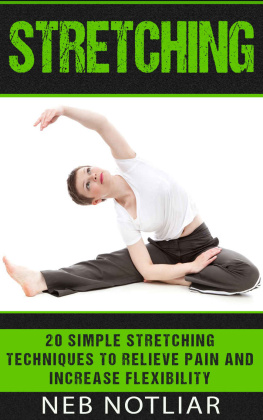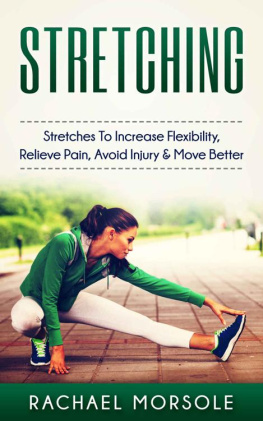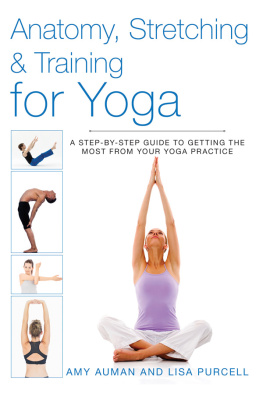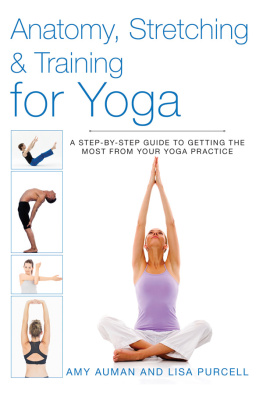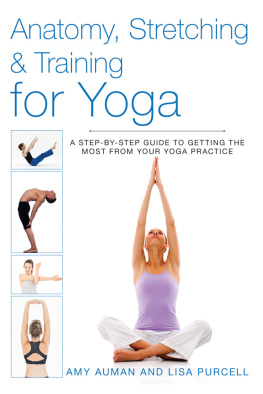ANATOMY OF STRETCHING
Beginners Step-By-Step Manual For Flexibility And Injury Recovery
Adams A. Smith
Copyright
This book may not be republished or photocopied without the permission of the author, as doing so will result in a penalty.
TABLE OF CONTENT
INTRODUCTION
CHAPTER 1 Anatomy, Flexibility and Physiology
Introduction to stretching
Physiology
Flexibility
Benefit of flexibility
Research and discussion
Factors affecting flexibility
CHAPTER 2 The Principles of Stretching
Guidelines on Applying the Principle of Stretching
CHAPTER 3 Types of Stretching
Static Stretching
Active
Passive
Static Stretching
PNF Stretching
Muscle energy technique (MET)
Ballistic Stretching
Neural Stretching
CHAPTER 4 Risks of poor flexibility and stretching
CHAPTER 5. Back Pain
Perception of low back
The low back anatomy
Actions of the Spine
Types of low back pain
Management of low back pain
CHAPTER 6 High-thigh Pain
Strains of quadriceps muscle
Tendon rapture of quadriceps
Groin strain
Hip pointer
Bursitis Trochanteric
Hamstring strain
Fracture of femoral neck
Hips avascular necrosis
Hip osteoarthritis
CHAPTER 7 Knee Stiffness
Meniscal tears
Tear in the anterior cruciate ligament (ACL)
PCL(posterior cruciate ligament) tear
Tear in the medial collateral ligament (MCL)
Damages of lateral collateral ligament (lcl)
Anterior knee pain
Ache femoral, patello (chondromalacia patella)
Jumper's knee
Osteoarthritis of the knee
CHAPTER 8 Ankle And Foot Stiffness
Ankle sprains / instability of the ankle
Fractures
Tendonitis achilles
Achilles tendon rupture
Fasciitis plantar
Tension fractures
Tipor tendinitis of the tibial issues
CHAPTER 9 Lumbar spondylosis
Pathophysiology
Grading
CHAPTER 10 Biceps Tendinopathy
Pathophysiology
Mechanic theory
Vascular theory
Neural modulation
CHAPTER 11 FIbromyalgia
Definition
Nomenclature
CHAPTER 12 Exercises for effective stretching
CHAPTER 13 Back Stretching
Double knee to chest stretch
Lower trunk rotation Stretch
Rotation stretch in the mid-back (spinal cord)
Back stretch
Cobra stretch
Baby pose (prayer stretch)
Double knees to side stretch
One leg to side stretch
CHAPTER 14 Neck Stretching
Neck glide
Neck elevation
Neck turning
Lateral extension
Sharp shrugs
Forward tilting flexion
Deep stretching
Presses of Resistance
Towel pull
CHAPTER 15 Upper Limb Stretch
Flexion extension stretching of the shoulder
Abduction-adduction stretching at the shoulder
Internal and external rotation stretching for shoulder
Flexion-extension stretching for elbow
Supination-pronation stretching of the forearm
Flexion-extension stretching for wrist
Finger flexion-extension stretching
Thumb extension
CHAPTER 16 Lower Limb Stretching
The adductors stretch
Quadriceps stretch
Calf stretch
Hamstring stretch
Piriformis stretch
Gluteal stretch
CHAPTER 17 Stretching Plan/Routine
How stretching helps
A beginner Stretching plan
Additional effective and optional stretching plan
Motivation for adequate stretch
What to expect after stretching
Conclusion and Summary
INTRODUCTION
I (the documents author) make no claims to being a stretching, anatomy, physiology, or other biological science expert. Im just trying to put together data that Ive read in books or been given by sources who are knowledgeable.
The methods, concepts, and recommendations in this document are not meant to be a replacement for expert medical advice! Any unaccustomed exercise or exercise technique should be discussed with a doctor or other health care provider before beginning, especially if you are pregnant, nursing, elderly, or have any recurring conditions. The reader is solely responsible for deciding whether to use any of the methods, concepts, or recommendations contained in this document.
"I'm not a doctor, and I don't play one on TV," or something similar I will not be held liable for any losses or harm you may incur as a result of relying on the information in this document, no matter how awful and useful it may be. No, not at all, even if the data is false. If you have any questions (or even if you don't) before beginning any unfamiliar exercise or exercise technique, you should always consult your doctor.
The anatomy of stretching, which was initially published in 2007, was the first book to briefly discuss the anatomy and physiology of stretching and flexibility. The subject has now been made into a popular course by many writers. Other than the original publication, no other book on the subject provides more examples of stretches and exercises or is able to describe them in a way that allows readers to find them useful and comprehend their advantages.
You'll learn in this book that the anatomy of stretching is far more complex than you ever imagined. It will take you inside the body and demonstrate to you how the major and secondary muscles work when you stretch.
Anatomy of Stretching Points, including the Value of Stretching, Types of Stretching, Effective Stretching Techniques, and Rules and Procedures for Safe Stretching.
To assist readers stretch correctly and efficiently, the topic of physiology has been enlarged, it has introduced 15 new stretches, and it has also provided a greater explanation of anatomy.
CHAPTER 1
ANATOMY, FLEXIBILITY AND PHYSIOLOGY
AN INTRODUCTION TO STRETCHING
Stretching is a form of physical exercise when a particular skeletal muscle (or muscle group) is purposefully extended, frequently via abduction from the torso, to increase the muscles perceived flexibility and reestablish comfortable muscular tone.
As a result, there is a sense of improved muscular control, flexibility, and range of motion. Stretching is another effective method for treating pains.
Stretching is an uncontrollable and natural behavior that many animals, including humans, engage in on a daily basis. Yawning may go along with it.
Stretching frequently happens on impulse after rising from sleep, after extended periods of inactivity, or after leaving restricted situations and regions.








